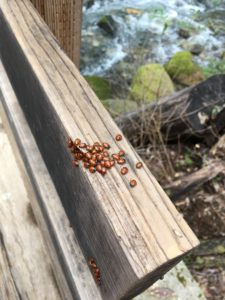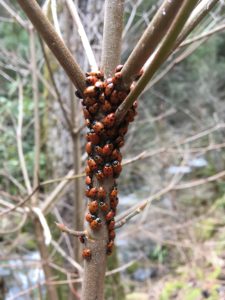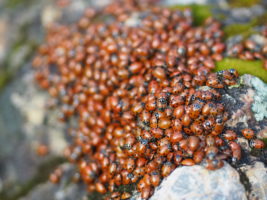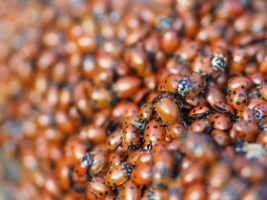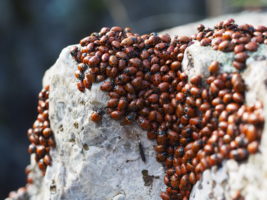The ladybug, ladybird beetle, or simply lady beetle, has a special place in our culture: A children’s favorite, loved by gardeners, enemy of aphids, bringer of good fortune. What’s more exciting than finding a ladybug? Finding thousands of them!

Ladybugs are migratory insects. Here in California, during the winter months, they travel from the valley to the foothills and clump together at specific spots, typically sunny areas near water, covering rocks and vegetation in a living red carpet.
The reason why the ladybugs clump together is not very well understood. Some studies suggest that clumping allows them to retain heat better and that the aggregated odor and color of the clump is a more effective predator deterrent, others argue that it’s also part of their mating ritual. One way or the other it’s a sight to behold.
A couple of weekends ago we went to Feather Falls trail in Plumas National Forest hoping to see this curious behavior. While we had seen clumps of ladybugs before, I had heard that their concentration near Frey Creek was remarkably high, so we had some high expectations.
My previous visit to this area was at the beginning of April and the ladybugs were nowhere to be seen. I assumed it was too late into the spring and that the lady-beetles had left the area already, but surely late February, with fresh snow on the ground, should be wintery enough!
I was a bit disappointed. We did find some ladybugs, but the numbers were not particularly impressive and nowhere near the reports I had heard of. What was going on?
Another popular clumping behavior is that of the Monarch Butterfly. A good spot to see them here in Northern California is in Santa Cruz, at Natural Bridges preserve. However, I’ve heard that lately their populations are dwindling and that this winter the number of butterflies was disturbingly low. Could the same be happening to the ladybugs?
After checking with some experts, it turns out that’s not the case. The most likely explanation is human harvesting! Ladybugs are used for pest control in organic gardening and the great majority of these ladybugs are harvested from the wild, from places like this.
I’m horrified! Not just because many of the ladybugs die during this process, but also, because removing them from the wild and not letting them disperse naturally, makes non-organic farmers even more dependent on pesticides.
This weekend the ladybugs were not in my mind anymore. Instead I was hoping to show the kids another curious animal phenomemon: the mating of the California newts. In early Spring the newts come back to the creeks in which they were born in order to mate and subsequently lay eggs. When the females are in heat, they attract large number of males, who clump around her in the hopes of coppulating in what appears to be an amphibian orgy.
A few years ago in early March I encountered several groups of newts mating while I hiked along the South Yuba River, and this weekend we were hoping to find them again.
Unfortunately, with the recent rains the water in the creeks was much higher than the last time I was here and it was flowing pretty fast for the newts to be returning to it already. We checked several creeks along a stretch of 4 miles with the same outcome. I was starting to think the trip was going to be another disappointment. However, when reaching our final destination: a particularly dramatic meander in the river where the valley opens up and gets a bit more sun light, we encountered an unexpected surprise: Thousands of ladybugs carpeting the ground!
Do you know of any other good spot to find overwintering ladybugs? Or of any other insect with a similar behavior? Please, share in the comments!
